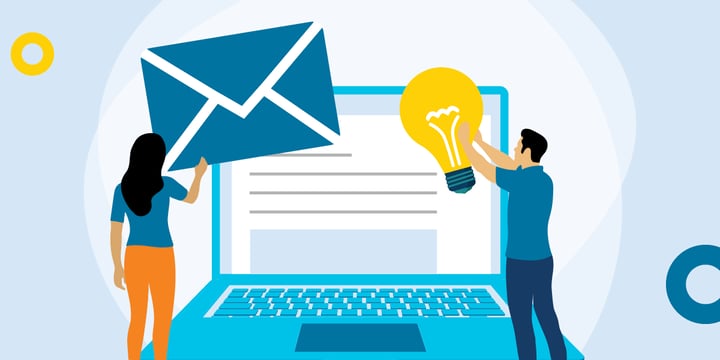The new year is a perfect time to reexamine and refine your email outreach efforts. Not sure where to begin? Here are some areas to focus on in 2023 and beyond.

Focus on New Subscribers
Without an ongoing stream of new list subscribers, your list will shrink over time due to attrition. But growing your list is only one part of the equation: You also want your subscribers to be actively engaged with your emails. Here are a few ways to start working toward that goal.
Grow Your List
A larger list means more prospective donors, volunteers, and people who can benefit from your organization's services. So it pays to invest in growing your email database.
Consider putting some of your budget into social media ads and search engine ads to make your organization more visible. And consider adding a prominent email subscription form to your website. Pop-up email subscription forms are a common approach, but you could also place a subscription message in a bar that runs at the bottom of the browser window, or place it in another highly visible location on your website.
You should not buy a list of contacts under any circumstances. People generally don't like getting emails they didn't sign up for, and doing so may violate anti-spam and GDPR laws. So resist the urge to take shortcuts.
Create an Onboarding Series
You want to engage your new subscribers as soon as possible; setting up an automated "welcome" series of emails is a good way to do just that. You can use a tool like Constant Contact or HubSpot to do this, ensuring that new subscribers feel valued and engaged with.
What this looks like will vary depending on your audience and your mission, but it may include messages that share more information about your organization and your work, educational or informational content, and ways for your list subscribers to become more involved. Perhaps you can use it to solicit donations or encourage your subscribers to volunteer.
In our case, we send a confirmation email as soon as someone fills out our subscription form. We follow that up a couple days later with an email that highlights some of our blog posts. Another email calls attention to our TechSoup Connect local meetups. And so on.
Improve Your Deliverability
In broad terms, "deliverability" refers to the likelihood that your message will appear in your recipients' inboxes and won't be relegated to the spam folder.
There are a few things you can do to accomplish this, but generally, it means being more focused and more thoughtful in how you email people. This, in turn, increases open rates, which improves your email sender reputation and reduces the chances that you'll be marked as spam.
Improve Targeting and Segmentation
"Batch and blast" is so 2015.
No two members of your email list are the same. So rather than send the same email to everyone on your list — the aforementioned batch and blast approach — it pays to tailor the content you send them based on your audience's interests. How you speak to a new list member, for example, should be different from how you speak to a major donor.
A new list member or prospective donor might be more interested in learning about your organization and the work that it does. Meanwhile, a regular donor might want to know more about how you're using their donations and the impact that it makes.
When you're considering how to break your audience down into segments, consider what your goal for that segment is. What do you want them to do? Become a small donor? Become a volunteer? Become a corporate sponsor? Something else? Then put yourself in your audience's shoes. What would you want to know? What would compel you to act? Then take it from there.
Depending on the size of your list, you can do this sorting manually or by using a database tool like Microsoft Access. Also, many email marketing tools include features that let you create dynamic lists that update automatically based on criteria that you set forth. For instance, you can create a list for all contacts in a certain geographic area based on information they provided and send them information about your activities in that region.
Reengage Lapsed Email Subscribers
In the process of defining segments of your email list, you may discover that a portion of your list simply isn't opening email. As we noted above, sending email to people who don't open it drives down your open rate, which hurts your deliverability. You'll probably want to stop emailing these unengaged contacts at some point, but before you cut them off, consider setting up a reengagement campaign.
A reengagement campaign is a series of emails that aims to, well, reengage members of your email list who may not have opened emails for a while. Often, these take the form of a series of emails asking if they want to continue receiving emails. Sometimes, they might receive a special offer of some sort.
If you've ever gotten an email from us asking if you want to update your email preferences, you've gotten one of our reengagement emails. We're not trying to be annoying, I promise; we're just trying to make sure we're able to reach people who want to get our email.
What this looks like will vary depending on your organization's needs and area of focus, so it's hard to give set guidelines here. But again, try to put yourself in the position of your recipients and consider what might motivate them to become more engaged with your organization's outreach. Either way, be prepared for some blowback, as the folks at the Nonprofit Marketing Guide discovered when they first ran a reengagement campaign.
Stop Sending Email to Unresponsive Contacts
If subscribers don't respond to reengagement campaigns, there's probably not much you can do to get them to start opening your emails. Some people might not be interested, your emails may be getting dumped into spam folders, or you've hit inactive email addresses. At this point, you should reduce the frequency with which you email them or stop emailing them entirely.
For more information, check out our blog post 6 Tips for Nonprofits to Improve Their Email Deliverability and Raise More Money Online.
Test, Test, Test
For each of these areas, you likely won't get it right the first time. So don't be afraid to try different things along the way.
Most email outreach tools offer some kind of A/B testing capability, which allows you to test a variable against a control. For example, you might want to see which kind of subject line results in more clicks. Something friendly? Something more serious and urgent in tone? You can also try out different layouts, different design elements, different body copy, different CTA buttons, and so on.
For best results, test only one variable per email (e.g., only the subject line or only the body copy). And be methodical about your testing. Test the same element in multiple emails for a bigger sample size. And determine whether your test results are statistically significant and not just a statistical fluke using an A/B test calculator. Here's one that we use in our email outreach.
Have Fun!
Improving your email marketing can be a challenging, rewarding, and dare I say, fun undertaking. And these are just a few of the things you can do in 2021 to enhance your email outreach efforts.
Not sure where to start? Our nonprofit marketing experts are here to help.
Got your own tips to share? Sound off in the TechSoup Community Forums.
Additional Resources
- Sign up for TechSoup Courses' Email Marketing for Nonprofits and Libraries Bundle.
- Find out about migrating your email in Operating More Flexibly and Productively with Cloud Email.
- Get some ideas about When to Change Your Broadcast Email Tool.







